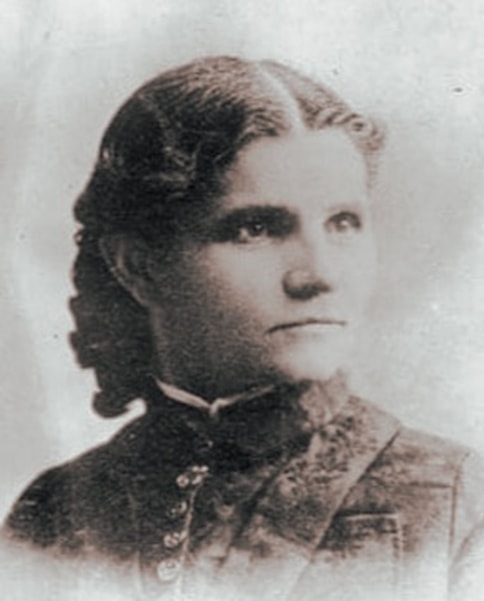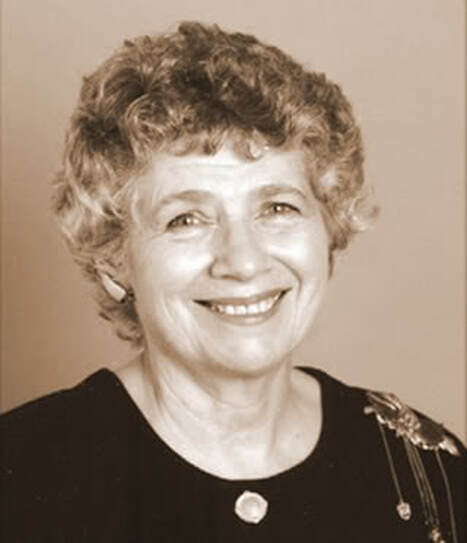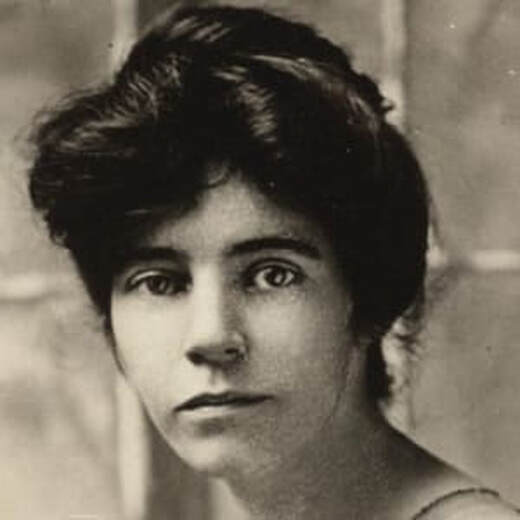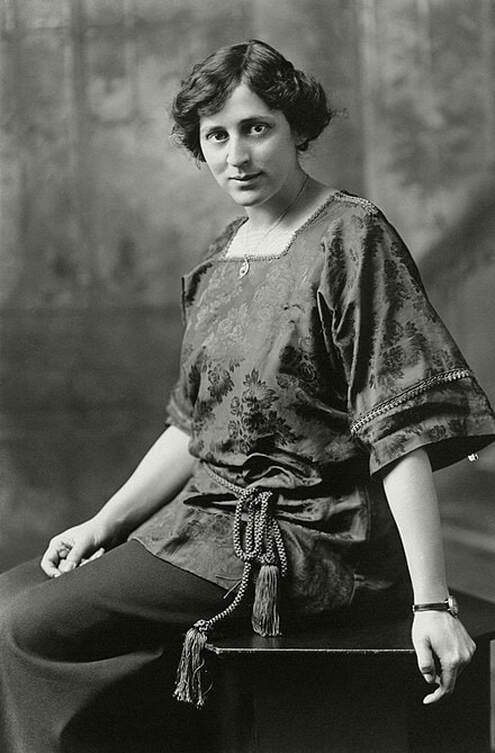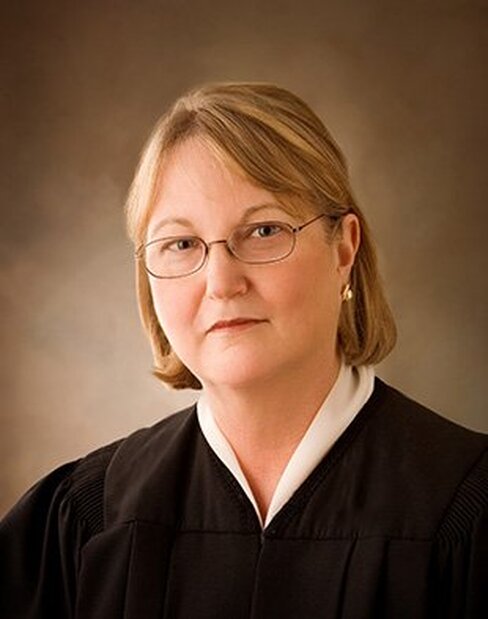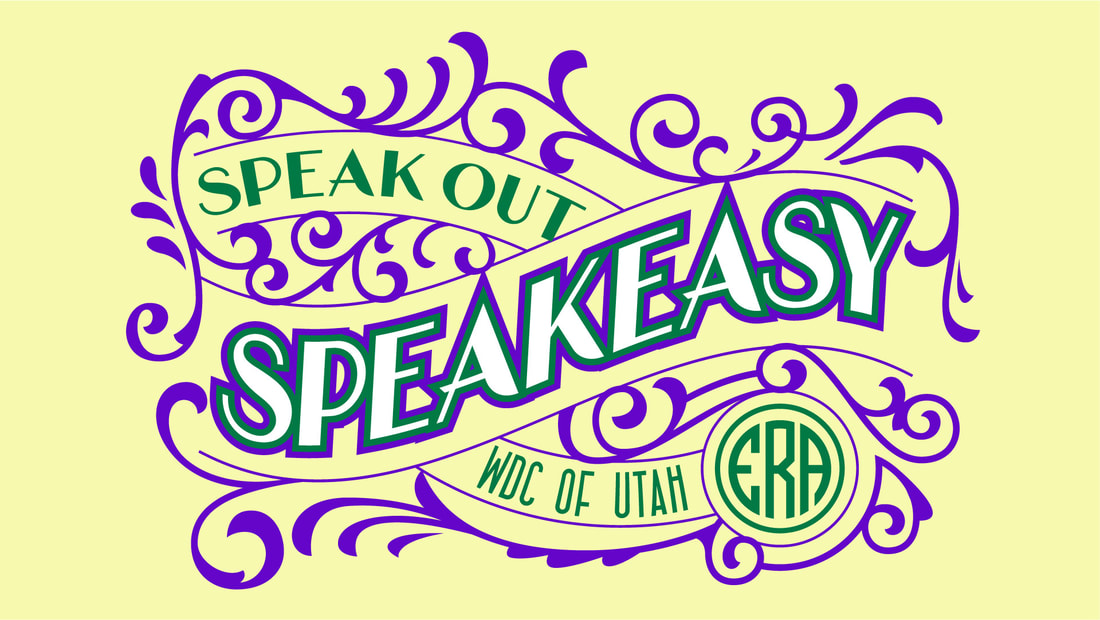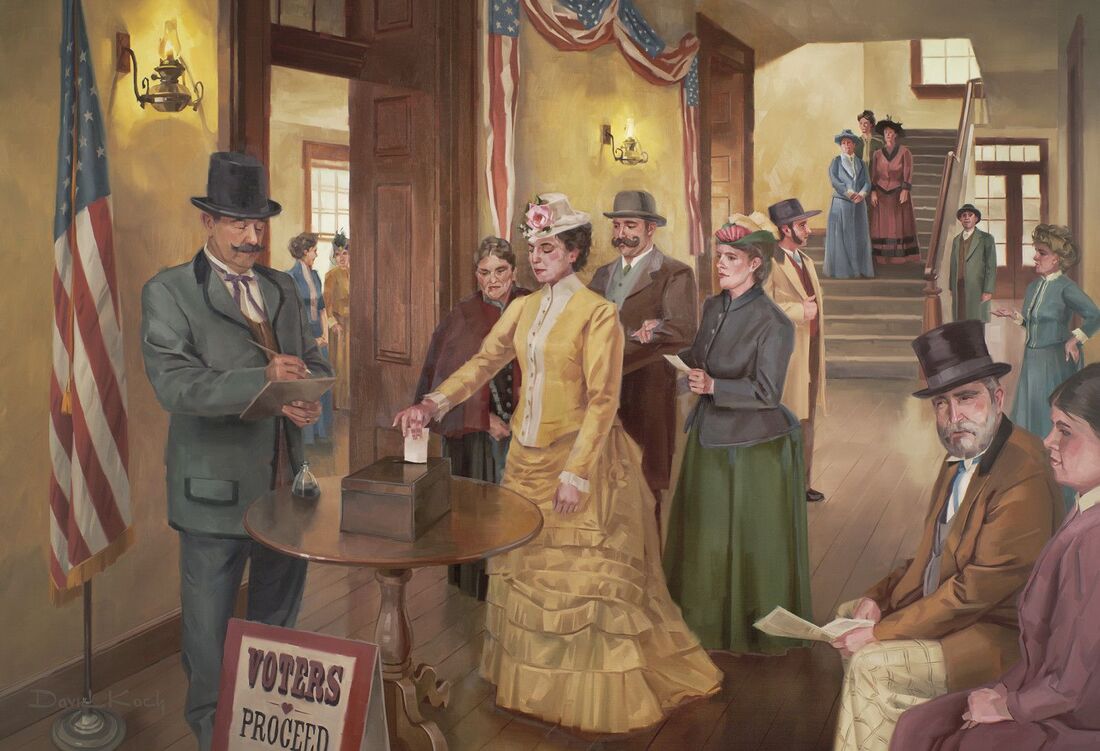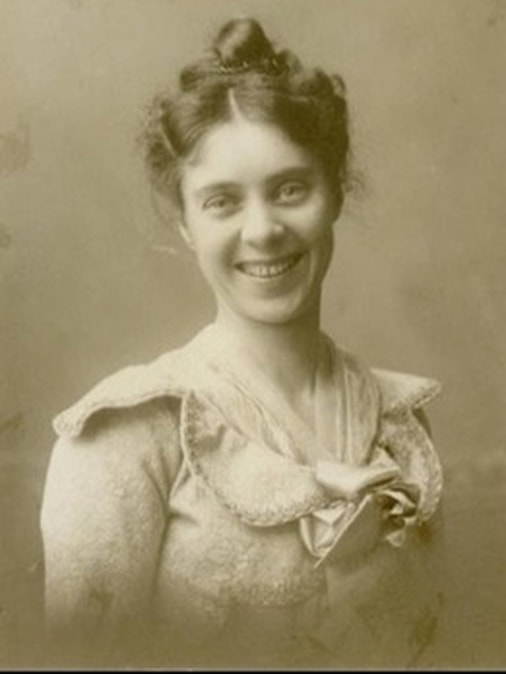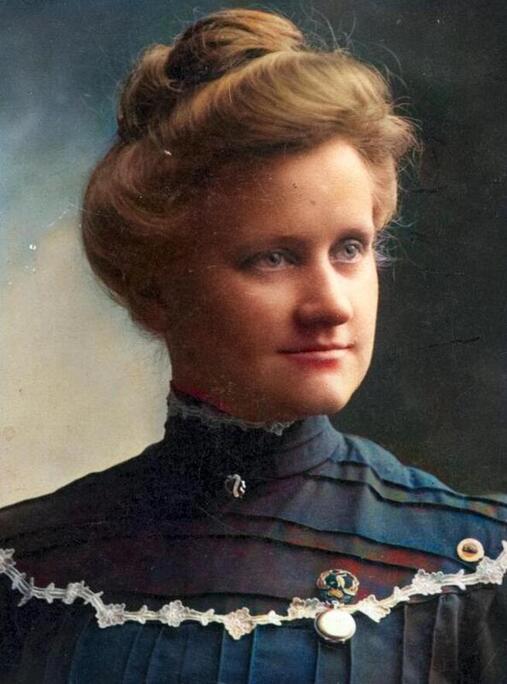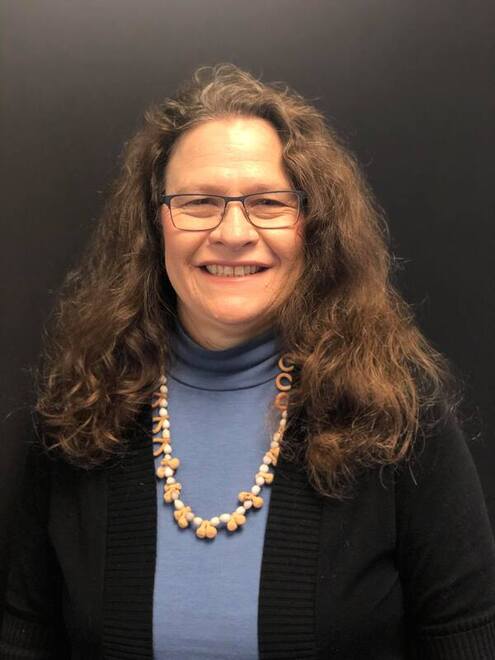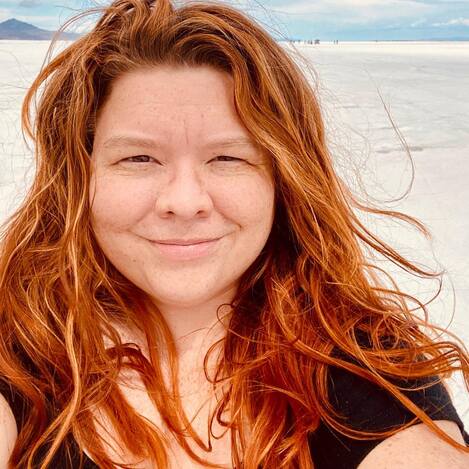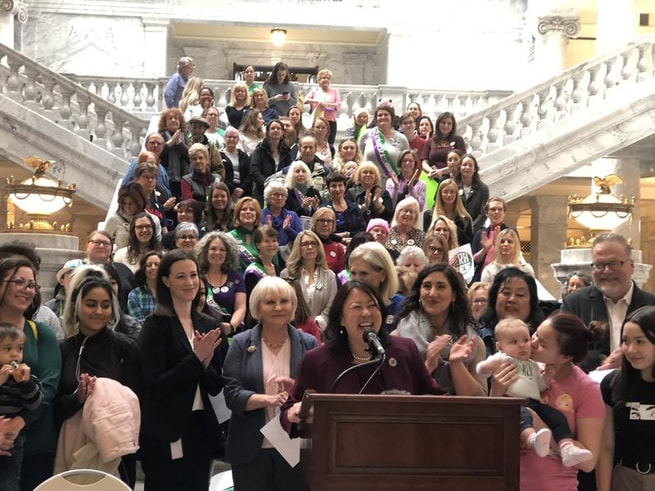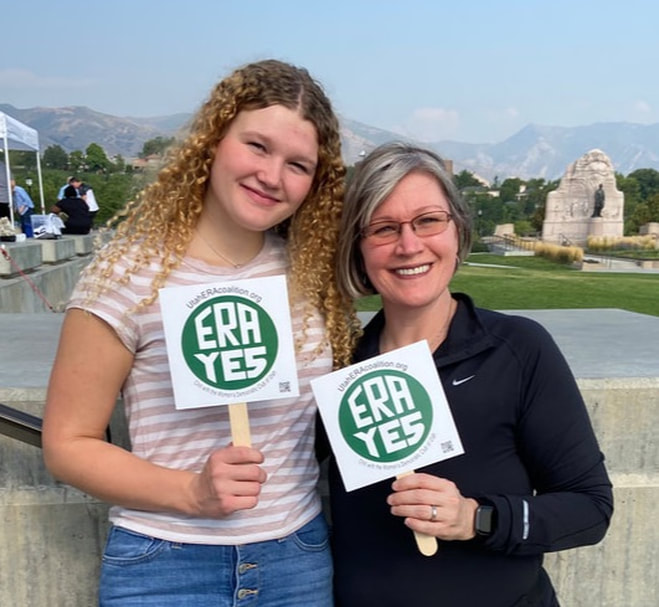Outstanding Contributions
in the Early History of
Utah's Deaf and Non-Deaf Women
in the Early History of
Utah's Deaf and Non-Deaf Women
Written by Jodi Becker Kinner
Published in 2017
Updated in 2024
Author's Note
As an Equal Rights Amendment enthusiast, I believe in recognizing and honoring the accomplishments of early Utah women throughout history. It's essential to acknowledge the enduring legacy of these women who, despite facing social, economic, professional, and political marginalization, have made a lasting impact on our society. By learning about the leadership achievements of Utah women, we can truly appreciate their contributions. Additionally, we can explore the history and leadership of equal rights for all and discuss strategies to encourage more people to engage in politics to uphold equal rights. Utah women were trailblazers in the areas of equality, voting rights, education, employment, and access, making significant strides that were ahead of their time. Unfortunately, this fact is often overlooked by the rest of the country. The purpose of this webpage is to reclaim and celebrate our influential history.
When writing about individuals for our history website, I choose to use their first name to acknowledge all individuals who contribute to and advocate for our community's causes. Our patriarchal culture often expects to recognize women's advocacy, contributions, and achievements using their husbands' last names instead of their own. However, in the spirit of inclusivity, equality, and recognizing each individual's unique identity, I have decided to use their first names throughout the website. This decision reaffirms our commitment to these values and highlights the significant role of women's advocacy in our community.
Our organization, previously known as the Utah Association for the Deaf, changed its name to the Utah Association of the Deaf in 2012. The association was known as the Utah Association of the Deaf from 1909 to 1962. The association changed its name to the Utah Association for the Deaf in 1963. Finally, in 2012, the association reverted to its previous name, the Utah Association of the Deaf. When writing the history website, I use both "of" and "for" to reflect the different eras of the association's history.
Thank you for your interest in reading 'Outstanding Contributions in the Early History of Utah's Deaf and Non-Deaf Women.'
Enjoy!
Jodi Becker Kinner
When writing about individuals for our history website, I choose to use their first name to acknowledge all individuals who contribute to and advocate for our community's causes. Our patriarchal culture often expects to recognize women's advocacy, contributions, and achievements using their husbands' last names instead of their own. However, in the spirit of inclusivity, equality, and recognizing each individual's unique identity, I have decided to use their first names throughout the website. This decision reaffirms our commitment to these values and highlights the significant role of women's advocacy in our community.
Our organization, previously known as the Utah Association for the Deaf, changed its name to the Utah Association of the Deaf in 2012. The association was known as the Utah Association of the Deaf from 1909 to 1962. The association changed its name to the Utah Association for the Deaf in 1963. Finally, in 2012, the association reverted to its previous name, the Utah Association of the Deaf. When writing the history website, I use both "of" and "for" to reflect the different eras of the association's history.
Thank you for your interest in reading 'Outstanding Contributions in the Early History of Utah's Deaf and Non-Deaf Women.'
Enjoy!
Jodi Becker Kinner
Women's Rights are Human Rights = Human Rights are Women's Rights.
~Utah Women Unite~
~Utah Women Unite~
Thousands Marched On Utah State Capitol
Calling For Women’s Equality
Calling For Women’s Equality
Disclaimer
This webpage is not intended to be critical of former U.S. President Donald J. Trump. Instead, it is intended to offer readers insight into the obstacles that women face when attempting to speak out against injustices, inequality, sexism, misogyny, and oppression they have faced over the years in a political system that is predominantly male-dominate.
The Global Women’s March
On Saturday, January 21, 2017, the Global Women's March took place, where an estimated 2.6 million people worldwide marched to raise their voices about women's inequality. Two days later, despite difficult weather conditions, ten thousand Utah residents marched to the Utah State Capitol to call on legislators to support equal rights for women, LGBTQ+, women of color, immigrant women, Muslim women, women with disabilities, and women with low or fixed incomes. "Utah Women Unite" organized the event to advocate for equality for millions of women who still face denial of fundamental human rights due to their gender. The participants in the event sent strong messages to Utah lawmakers and said they were ready to defend the progress their mothers and grandmothers fought for (Gehrke, The Salt Lake Tribune, January 23, 2017).
Within 24 hours of President Donald J. Trump's inauguration, organizers organized the Global Women's March. People perceived a backward agenda as an immediate threat to women's civil rights and liberties. Kate Kelly, a prominent American activist, Mormon feminist, and human rights attorney who was instrumental in organizing the 'Utah Women Unite' event, voiced her frustration, stating, "I'm sick and tired of men making laws about our bodies, our choices, and our lives without consulting us!" (Vaglanos, The Huffington Post, January 25, 2017).
Within 24 hours of President Donald J. Trump's inauguration, organizers organized the Global Women's March. People perceived a backward agenda as an immediate threat to women's civil rights and liberties. Kate Kelly, a prominent American activist, Mormon feminist, and human rights attorney who was instrumental in organizing the 'Utah Women Unite' event, voiced her frustration, stating, "I'm sick and tired of men making laws about our bodies, our choices, and our lives without consulting us!" (Vaglanos, The Huffington Post, January 25, 2017).

A group of ASL/Deaf Women at the Utah Women's March in the Utah State Capitol on January 23, 2017. Back Row: L-R: Jennifer Allen-Kelly, Sari Stewart Williams, Dawn Duran (ASL Interpreter), Stephanie Lowder Mathis, and Chrystee Call Davenport. Front Row L-R: Shandra Benito, Jodi Becker Kinner, Millicent "Millie" Simmonds (a Deaf actress), and Carol Sanderson
Utah Women's Suffrage Movement
In the 1800s, women in Utah were actively involved in politics and fought for equal rights, including the right to vote. They were commonly referred to as "suffragists." Utah is renowned for being an exemplary state when it comes to women's rights, and prominent figures in Utah politics during that time made significant contributions to the movement.
Emily Sophia Tanner Richards proposed that Utah create a suffrage group that would be affiliated with the National Woman Suffrage Association. She developed close relationships with prominent leaders such as Susan B. Anthony, Anna Howard Shaw, and Carrie Chapman Catt. Emily's husband, Franklin S. Richards, also advocated for equal suffrage. In comparison to other states, Utah had the highest number of members in the National American Woman Suffrage Association. At that time, the National American Woman Suffrage Association prohibited women from pursuing higher education or a career, signing contracts, maintaining their jobs, or owning property.
Woman's Exponent,
a Progressive Newspaper
a Progressive Newspaper
Between 1872 and 1914, Mormon women of The Church of Jesus Christ of Latter-day Saints produced The Woman's Exponent. The editors were Lula Greene Richards and Emmeline B. Wells. The mission of The Exponent was to empower and support Mormon women by addressing topics such as women's suffrage, social and political issues, and plural marriage, which was abolished in 1890. Unfortunately, after a successful 42-year run, financial difficulties forced the newspaper to cease publication in 1914 (Brooks, Steenblik & Wheelwright, 2016).
During his time as Utah Governor and President of The Church of Jesus Christ of Latter-day Saints, Brigham Young encouraged women to pursue education and careers. He believed that women were not only useful for traditional domestic roles such as sweeping, washing, and raising children, but they should also have the opportunity to work in businesses, study law and physics, or become bookkeepers. This would increase their sphere of usefulness for the benefit of society at large (Brooks, Steenblik & Wheelwright, 2016).
Under President Young's leadership, women could also work and pursue progressive careers. They were also able to advance their political agendas, even while practicing polygamy and pursuing their academic and professional goals. Women held various roles in academia, medicine, teaching, writing, and politics (Brooks, Steenblik, & Wheelwright, 2016). According to historians, Mormon feminists have existed for as long as Mormonism itself, dating back to the founding of The Church of Jesus Christ of Latter-day Saints in 1830 (Havens, The Spectrum, February 24, 2018).
Under President Young's leadership, women could also work and pursue progressive careers. They were also able to advance their political agendas, even while practicing polygamy and pursuing their academic and professional goals. Women held various roles in academia, medicine, teaching, writing, and politics (Brooks, Steenblik, & Wheelwright, 2016). According to historians, Mormon feminists have existed for as long as Mormonism itself, dating back to the founding of The Church of Jesus Christ of Latter-day Saints in 1830 (Havens, The Spectrum, February 24, 2018).
"The future will deal more generously with womankind, and the historian of the present age will find it very embarrassing to ignore woman."
~Emmeline B. Wells~
~Emmeline B. Wells~
After 1920, women's power and status in the church and politics began to decline, and they continued to do so until the 1960s. During this time, The Church of Jesus Christ of Latter-day Saints collaborated with the Relief Society, one of the world's oldest and largest women's groups, to achieve its global development goals. However, men supervised the Relief Society's finances, operations, and publications between 1960 and 1970, leading to a loss of power and independence for women. Between 1970 and 1980, the church promoted the traditional family structure, discouraging women from having careers outside the home. Many mothers complied with this and chose to raise their children at home instead. As a result, the number of mothers increased over time, with Utahn women enrolling in college at a lower rate than women nationwide (Brooks, Steenblik & Wheelwright, 2016).
From 1870 to 1970, Latter-day Saint women's leadership and accomplishments were overlooked, mainly until the early 1970s, when the Boston Mormon feminists began publishing the Women's Exponent magazines in 1974, which are still up and running. Additionally, Neylan McBaine founded the non-profit organization "Better Days 2020" to recognize and promote the accomplishments of women in Utah's leadership and elevate their status.
From 1870 to 1970, Latter-day Saint women's leadership and accomplishments were overlooked, mainly until the early 1970s, when the Boston Mormon feminists began publishing the Women's Exponent magazines in 1974, which are still up and running. Additionally, Neylan McBaine founded the non-profit organization "Better Days 2020" to recognize and promote the accomplishments of women in Utah's leadership and elevate their status.
The Relaunch of the
Woman's Exponent II Magazine & Blog
Woman's Exponent II Magazine & Blog
During the ratification of the Equal Rights Amendment, known as the ERA, from 1972 to 1982, Susan Kohler, a feminist who was also a member of the Mormon community in Boston, stumbled upon a collection of Exponent newspapers. These newspapers, authored by feminist-minded Mormon women, were archived at Harvard University's Widener Library and the Boston Public Library. The discovery of these newspapers inspired Dr. Claudia Lauper Bushman and Dr. Laurel Thatcher Ulrich, who launched Exponent II magazine in July 1974. This magazine is the longest-running independent publication for Latter-day Saint women (Brooks, Steenblik & Wheelwright, 2016).
The Exponent II, a publication by and for Mormon women, has been referred to as "The spiritual descendant of the Woman's Exponent" by the Boston Mormon Feminists. According to Claudia Bushman, the women who spoke out before them were role models for their own lives. The primary goal of Exponent II is to strengthen The Church of Jesus Christ of Latter-day Saints and to encourage and develop the talents of Mormon women. The publication also focuses on the experiences and concerns of diverse Mormon women from a feminist perspective. It is worth noting that Exponent II is the longest-running independent publication for and by Mormon women, publishing quarterly (Brooks, Steenblik & Wheelwright, 2016). If you want to learn more, check out the Exponent II link.
Interestingly, in 1976, Dr. Laurel Thatcher Ulrich, a Mormon feminist, historian, and Harvard University professor, coined the phrase, "Well-behaved women seldom make history," which has become popular and can now be found on various items like greeting cards, t-shirts, mugs, and bumper stickers.
Interestingly, in 1976, Dr. Laurel Thatcher Ulrich, a Mormon feminist, historian, and Harvard University professor, coined the phrase, "Well-behaved women seldom make history," which has become popular and can now be found on various items like greeting cards, t-shirts, mugs, and bumper stickers.
The Century-Long Battle
to Pass the Equal Rights Amendment
to Pass the Equal Rights Amendment
Women gained the right to vote in 1920, but civil rights activists Alice Paul and Crystal Eastman found it insufficient. As influential National Women's Party leaders, they penned the Equal Rights Amendment (ERA) to ensure "equal justice under the law" for everyone, protect individuals from discrimination based on sex, gender identity, and sexual orientation, and advance equality and personal freedoms.
The Equal Rights Amendment, a significant milestone in the history of women's rights, was introduced at the 75th anniversary of the 1848 Women's Rights Convention in Seneca Falls, New York. This was a momentous event that marked a new chapter in the fight for gender equality. In December 1923, the U.S. Congress received the ERA proposal, a significant step forward in the women's rights movement. Despite the initial failure at its first session, the movement persisted. It took every session attempt until March 22, 1972, when the Senate and the House of Representatives finally passed the amendment. However, unlike other amendments, the U.S. Congress compromised the achievement by imposing a seven-year time limit on the ratification process. Many states quickly moved to pass it at the start of 1972. However, in 1977, when the ERA came to Utah, The Church of Jesus Christ of Latter-day Saints objected on moral grounds and blocked the vote. The ERA required 38 state ratifications to become law, but by the original seven-year time limit, it had yet to reach that number. Congress voted to extend the time limit for an additional three years, but by the deadline of June 30, 1982, the ERA remained three states short of the necessary 38 (Alice Paul Institute website).
For a deeper understanding of the ERA's impact on Mormon women, the document 'Mormon Feminism in 1977 and Today' provides a comprehensive look at their responses during the International Women's Year in 1975 and the National Women's Conference in 1977.
The Equal Rights Amendment, a significant milestone in the history of women's rights, was introduced at the 75th anniversary of the 1848 Women's Rights Convention in Seneca Falls, New York. This was a momentous event that marked a new chapter in the fight for gender equality. In December 1923, the U.S. Congress received the ERA proposal, a significant step forward in the women's rights movement. Despite the initial failure at its first session, the movement persisted. It took every session attempt until March 22, 1972, when the Senate and the House of Representatives finally passed the amendment. However, unlike other amendments, the U.S. Congress compromised the achievement by imposing a seven-year time limit on the ratification process. Many states quickly moved to pass it at the start of 1972. However, in 1977, when the ERA came to Utah, The Church of Jesus Christ of Latter-day Saints objected on moral grounds and blocked the vote. The ERA required 38 state ratifications to become law, but by the original seven-year time limit, it had yet to reach that number. Congress voted to extend the time limit for an additional three years, but by the deadline of June 30, 1982, the ERA remained three states short of the necessary 38 (Alice Paul Institute website).
For a deeper understanding of the ERA's impact on Mormon women, the document 'Mormon Feminism in 1977 and Today' provides a comprehensive look at their responses during the International Women's Year in 1975 and the National Women's Conference in 1977.
The U.S. Constitution still did not incorporate the Equal Rights Amendment, despite a decade of legislative battles over gender equality, bodily autonomy, reproductive healthcare, contraception access, same-sex marriage, transgender rights, the female military draft, gender-neutral restrooms, and other issues. The United States Constitution continued to deny women equal rights and protections.
In her article for The Salt Lake Tribute, Kelly Whited Jones, a Utah ERA activist, mentioned that former Utah Supreme Court Justice Christine Durham, Congresswoman Karen Shepherd, Eileen Fisher, and Carol Lynn Pearson relentlessly fought to ratify the ERA in Utah during the 1970s. However, women were disappointed when the timeline expired and Utah failed to ratify the ERA. Carol Lynn Pearson's diary entry from June 30, 1982 reveals that the majority of the opposition to the ERA was misogynistic, which is disheartening. Nonetheless, the issue is not dead, and the change in consciousness about women still exists. Carol believed that a new perception would not go away (Jones, The Salt Lake Tribute, July 22, 2023).
After almost 40 years of waiting, the campaigns to enact the ERA were renewed after the failure to renew the Violence Against Women Act of 1994 (which expired in 2018 and was reauthorized in 2022), the #MeToo movement, and the Women's March in 2017. Following Illinois, which ratified the ERA as the 37th state in 2018, Nevada became the 36th state to do so in 2017. Virginia was the 38th and last state to ratify the ERA in 2020, fulfilling the requirements for ratification.
In 2016, women brought the ERA back to Utah with the support of Sen. Jim Dabakis, Rep. Karen Kwan, and Sens. Kathleen Riebe and Kirk Cullimore. Their bills had strong backing across the state, with two independent polls indicating that more than 71% of Utahns support ratifying the ERA (Jones, The Salt Lake Tribute, July 22, 2023). For years, Utah women attempted to pass an ERA resolution and failed multiple times. The Utah Legislature still declined to recognize women as legal equals. The leaders of The Church of Jesus Christ of Latter-day Saints argued in writing and through lobbying efforts that the law would increase abortions, introduce unisex restrooms, and harm families.
After almost 40 years of waiting, the campaigns to enact the ERA were renewed after the failure to renew the Violence Against Women Act of 1994 (which expired in 2018 and was reauthorized in 2022), the #MeToo movement, and the Women's March in 2017. Following Illinois, which ratified the ERA as the 37th state in 2018, Nevada became the 36th state to do so in 2017. Virginia was the 38th and last state to ratify the ERA in 2020, fulfilling the requirements for ratification.
In 2016, women brought the ERA back to Utah with the support of Sen. Jim Dabakis, Rep. Karen Kwan, and Sens. Kathleen Riebe and Kirk Cullimore. Their bills had strong backing across the state, with two independent polls indicating that more than 71% of Utahns support ratifying the ERA (Jones, The Salt Lake Tribute, July 22, 2023). For years, Utah women attempted to pass an ERA resolution and failed multiple times. The Utah Legislature still declined to recognize women as legal equals. The leaders of The Church of Jesus Christ of Latter-day Saints argued in writing and through lobbying efforts that the law would increase abortions, introduce unisex restrooms, and harm families.
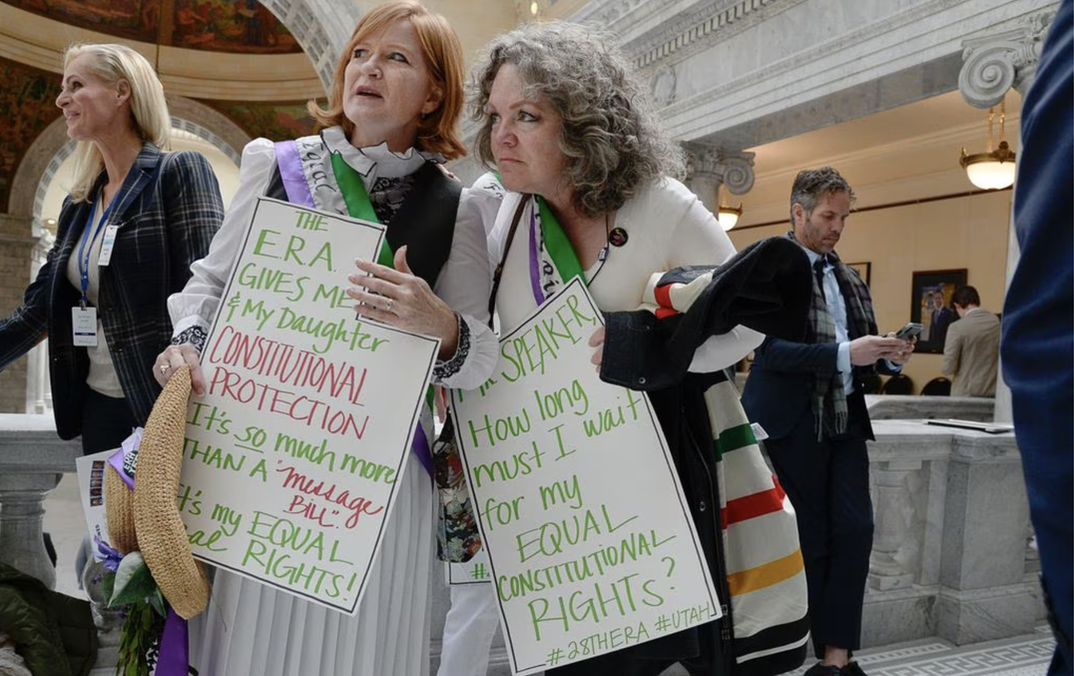
(Francisco Kjolseth | The Salt Lake Tribune) Kelly Jones, left, and Jody England Hansen dress up as Silent Sentinels (women who protested outside the White House a century ago for suffrage), as they attend the legislative session on Tuesday, Feb. 4, 2020, to encourage Utah legislators to ratify the Equal Rights Amendment.
Kelly Whited Jones emphasized that the ERA will ensure that federal laws cannot discriminate against people based on gender. Furthermore, the ERA requires courts to use a higher standard in sex discrimination cases. This means that more people can seek justice in the courts. In Utah, for example, prosecutors filed only 11% of sexual assault charges in 2023. Domestic abuse laws do not protect survivors, with Utah's one-in-three rate of domestic assault exceeding the national average of one in five. Human resource departments fail to safeguard female employees. Human resource departments frequently punish, fire, or subject those who report violations to expensive legal bills. The Equal Rights Amendment is necessary to protect women at work, at university, and at home. Despite advances in this century, women will still face major barriers to equality in 2023. Furthermore, this year stripped away women's rights to medical privacy and physical autonomy, while men's medical rights remained intact. The elimination of standards for equality in university admissions has led to the legalization of gender discrimination in employment (Jones, The Salt Lake Tribute, July 22, 2023).
According to Kelly Whited Jones, "Utah remains one of only 12 unratified states." She believes that after a century, it is long overdue to fulfill what Utah women have been fighting for and what pioneering women began a century ago in Seneca Falls. Carol Lynn Pearson congratulates the women and men in Utah who continue to support the Equal Rights Amendment (ERA) and gives her "personal blessing and belief that success is near" (Jones, The Salt Lake Tribute, July 22, 2023).
According to Kelly Whited Jones, "Utah remains one of only 12 unratified states." She believes that after a century, it is long overdue to fulfill what Utah women have been fighting for and what pioneering women began a century ago in Seneca Falls. Carol Lynn Pearson congratulates the women and men in Utah who continue to support the Equal Rights Amendment (ERA) and gives her "personal blessing and belief that success is near" (Jones, The Salt Lake Tribute, July 22, 2023).
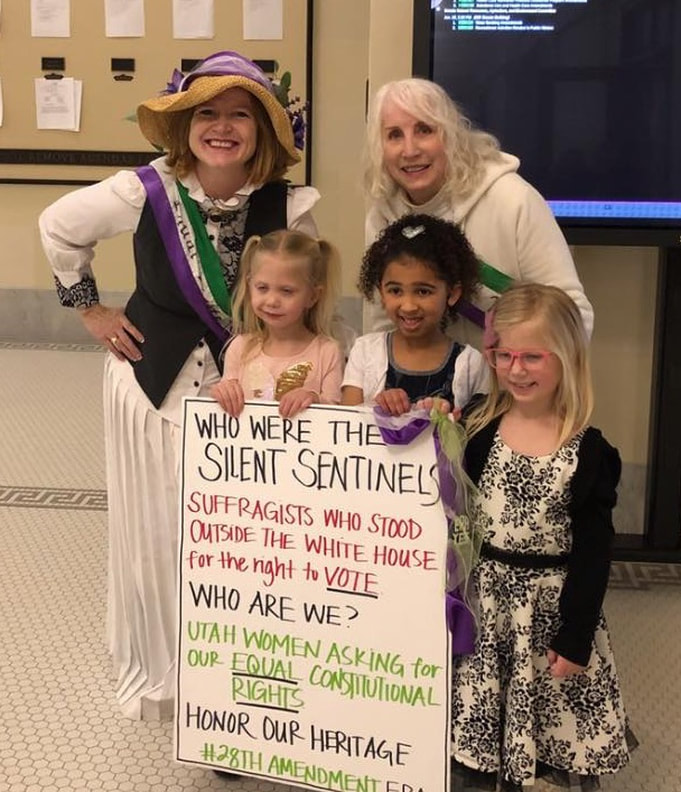
While attending the 2020 legislative session at the Utah State Capitol, Kelly Whited Jones, a founding member of the Utah ERA Coalition, and her supporter, Jody England Hasnsen, met remarkable young girls from the Utah Schools for the Deaf and the Blind. On Facebook on January 29, 2020, she expressed her belief that working towards equality is worth striving for.
Now that 38 states have ratified the Equal Rights Amendment, the next step is to repeal the 1982 deadline and make the ERA a permanent part of the U.S. Constitution. Hundreds of constitutional experts agreed that the ERA had fulfilled all the requirements outlined in the Constitution to become an amendment. Two-thirds of Congress passed it in 1972, and three-fourths (38) of the states ratified it in 2020. The majority of Americans support the Equal Rights Amendment and advocate for its incorporation into the U.S. Constitution. Representative Cori Bush of Missouri and Senator Kirsten Gillibrand of New York, both ERA advocates, argued that there is no mention of timelines in the Constitution. They also stated that the Executive Branch has no authority to stop an amendment. For example, the 27th Amendment took 203 years (1789–1992) to become law. Yes, you read that correctly—203 years! Similarly, we've been ratifying the Equal Rights Amendment for a century and still counting.
The Equal Rights Amendment satisfies all constitutional amendment requirements and is ready for publication. However, the Trump Administration's Office of Legal Counsel, National Archivist, and Justice Department have used the deadline to block the final enshrinement of the ERA in the Constitution, citing legal and political debates surrounding the deadline for ratification. The ERA is currently in limbo due to legal issues that allow the U.S. Archivist to withhold certification despite the U.S. House of Representatives voting in favor of a Democratic-sponsored joint resolution to remove the 1982 deadline on February 13, 2020, and March 17, 2021. On April 26, 2023, the Senators voted against removing the amendment's arbitrary deadline, even though they have the power to change or remove it. 98 of the 100 Senators were present, and 52 of them voted to incorporate the ERA into the U.S. Constitution, falling short by eight votes due to an old rule known as "filibustering," which requires 60 votes. Every Democrat and two Republicans, Senators Lisa Murkowski and Susan Collins, voted in favor of the ERA. Every other Republican senator voted against it.
Beyond that, Senator Mitt Romney of Utah, the 2012 Republican presidential nominee, actively opposes certification efforts. He and other ERA opponents sent a letter to the archivist on February 8, 2022, requesting that the archivist not certify and publish the ERA, which denied women's complete equality under the law, as guaranteed by our Constitution. This block deprived women of equal rights, making them second-class citizens. The ERA serves as the last line of defense against sex discrimination in all sectors, including gender equality, Title XI protections for the right to gender-affirming and reproductive healthcare, access to birth control and abortion, fertility treatments, LGBTQ+ protection rights, racial justice, equal pay, equal justice for sexual harassment and abuse, and so on. It has fueled the women's movement, particularly among the younger generation, which advocates for gender equality and legal protection for women's rights.
In 2019, Christine M. Durham, the first female appointed to the Utah Supreme Court, encouraged the next generation: "The torch is being passed from women of my generation to your generation, and it's very important to educate yourself about the future and the past" (Collett, 2019). Young people are spearheading the ERA movement, bringing it closer than ever to formal recognition as a constitutional amendment.
The Equal Rights Amendment satisfies all constitutional amendment requirements and is ready for publication. However, the Trump Administration's Office of Legal Counsel, National Archivist, and Justice Department have used the deadline to block the final enshrinement of the ERA in the Constitution, citing legal and political debates surrounding the deadline for ratification. The ERA is currently in limbo due to legal issues that allow the U.S. Archivist to withhold certification despite the U.S. House of Representatives voting in favor of a Democratic-sponsored joint resolution to remove the 1982 deadline on February 13, 2020, and March 17, 2021. On April 26, 2023, the Senators voted against removing the amendment's arbitrary deadline, even though they have the power to change or remove it. 98 of the 100 Senators were present, and 52 of them voted to incorporate the ERA into the U.S. Constitution, falling short by eight votes due to an old rule known as "filibustering," which requires 60 votes. Every Democrat and two Republicans, Senators Lisa Murkowski and Susan Collins, voted in favor of the ERA. Every other Republican senator voted against it.
Beyond that, Senator Mitt Romney of Utah, the 2012 Republican presidential nominee, actively opposes certification efforts. He and other ERA opponents sent a letter to the archivist on February 8, 2022, requesting that the archivist not certify and publish the ERA, which denied women's complete equality under the law, as guaranteed by our Constitution. This block deprived women of equal rights, making them second-class citizens. The ERA serves as the last line of defense against sex discrimination in all sectors, including gender equality, Title XI protections for the right to gender-affirming and reproductive healthcare, access to birth control and abortion, fertility treatments, LGBTQ+ protection rights, racial justice, equal pay, equal justice for sexual harassment and abuse, and so on. It has fueled the women's movement, particularly among the younger generation, which advocates for gender equality and legal protection for women's rights.
In 2019, Christine M. Durham, the first female appointed to the Utah Supreme Court, encouraged the next generation: "The torch is being passed from women of my generation to your generation, and it's very important to educate yourself about the future and the past" (Collett, 2019). Young people are spearheading the ERA movement, bringing it closer than ever to formal recognition as a constitutional amendment.
Dr. Ellen Brady, the Issues Director for the Women's Democratic Club of Utah, points out that the United States is one of only six countries that has not signed the United Nations Convention on the Elimination of All Forms of Discrimination Against Women. This international agreement guarantees women a long list of rights, protections, and equality. The United States is in the company of Sudan, Iran, and Somalia, among others, for not ratifying this convention. Additionally, the United States is one of only ten out of 195 countries that does not ensure gender equality in its constitution. We still need to make that theoretical equality a reality. Dr. Brady also stated in the Standard-Examiner on June 21, 2023, that the United States needs to take the lead, not follow (Brady, Standard-Examiner, June 21, 2023).
It's worth noting that on March 31, 1776, Abigail Adams, the future First Lady, urged her husband John, who was then a member of the Continental Congress and later became the second president of the United States, to "remember the ladies and be more generous and favorable to them than your ancestors. Do not put such unlimited power into the hands of the husbands. Remember, all men would be tyrants if they could. If particular care and attention are not paid to the ladies, we are determined to foment a rebellion and will not hold ourselves bound by any laws in which we have no voice or representation" (history.com). Despite her plea, it took 144 years for women to receive the right to vote. Nevertheless, the Equal Rights Amendment still requires ratification by 2023, 247 years after her petition and 100 years after its introduction.
It's worth noting that on March 31, 1776, Abigail Adams, the future First Lady, urged her husband John, who was then a member of the Continental Congress and later became the second president of the United States, to "remember the ladies and be more generous and favorable to them than your ancestors. Do not put such unlimited power into the hands of the husbands. Remember, all men would be tyrants if they could. If particular care and attention are not paid to the ladies, we are determined to foment a rebellion and will not hold ourselves bound by any laws in which we have no voice or representation" (history.com). Despite her plea, it took 144 years for women to receive the right to vote. Nevertheless, the Equal Rights Amendment still requires ratification by 2023, 247 years after her petition and 100 years after its introduction.
Interestingly, Utah enacted its own Equal Rights Amendment in 1895, which ensured equal rights and protection for women in the state. According to Article IV, Section 1 of Utah's Constitution, "both male and female citizens of this state shall equally enjoy all civil, political, and religious rights and benefits". Despite this, Utah had several opportunities to ratify the federal Equal Rights Amendment, which failed due to the state legislature's decision not to recognize women as equal citizens under the law (Quist, The Salt Lake Tribune, October 3, 2019). However, the majority of people in Utah and the rest of the United States support the amendment, with 74% and 94%, respectively, in favor of it (Rich, 2020). Therefore, lifting the 1982 deadline is the next step in promoting gender equality in the United States and ensuring the Equal Rights Amendment's permanent inclusion in the US Constitution. For more information on Mormons for the Equal Rights Amendment, please see "From Housewives to Protestors: The Story of Mormons for the Equal Rights Amendment."
The ERA is important because it helps protect social justice, including protective legislation such as Roe v. Wade, the Violence Against Women Act, Title IX protections, reproductive health rights, and equal pay. Roe v. Wade serves as an example of how attacks and overturns of these rights could occur without the ERA. Despite the removal of many barriers, such as gender-neutral restrooms, LGBTQ+ rights, and women in the military, we still require a permanent and effective guarantee of gender equality. After years of striving for social justice, the U.S. Supreme Court's recent decisions have rolled back our rights and weakened democracy, effectively turning back the clock on progress.
The ERA is important because it helps protect social justice, including protective legislation such as Roe v. Wade, the Violence Against Women Act, Title IX protections, reproductive health rights, and equal pay. Roe v. Wade serves as an example of how attacks and overturns of these rights could occur without the ERA. Despite the removal of many barriers, such as gender-neutral restrooms, LGBTQ+ rights, and women in the military, we still require a permanent and effective guarantee of gender equality. After years of striving for social justice, the U.S. Supreme Court's recent decisions have rolled back our rights and weakened democracy, effectively turning back the clock on progress.
Women still don't have equal rights
in the U.S. Constitution
in the U.S. Constitution
On July 13, 2023, the Supreme Court overruled Roe v. Wade, leading to the implementation of the ERA Now Resolution. This marks the first time in history that two women introduced Equal Rights Amendment legislation with female sponsors in both the House and Senate. Representative Cori Bush from Missouri and Senator Kirsten Gillibrand from New York introduced the ERA Now Resolution, which instructs the National Archivist to certify and publish the 100-year-old Equal Rights Amendment and declares it the 28th Amendment to the U.S. Constitution. Colleen Shogan, the country's first female National Archivist, should properly ratify and publish the gender equality legislation as the 28th Amendment immediately, they argued. Two female legislators, Cori Bush and Kirsten Gillibrand, are pushing the ERA for the first time in the House and Senate, reflecting the growing BIPOC and LGBTQ+ communities of the movement as a whole, as they campaign for gender equality in and out of the U.S. Congress. Rep. Bush, Sen. Gillibrand, and ERA advocates do not want to waste time fighting procedural obstacles or waiting for more Republican support. Therefore, they asked President Joe R. Biden to authorize the National Archivist to certify and publish the 28th Amendment immediately. They contended that the deadlines lack validity and that the U.S. Constitution ought to incorporate gender equality. The resolution instructed the National Archivist, who is responsible for publishing the amendment in the Executive Branch, to do so.
First introduced in 1923, the Equal Rights Amendment marked its 100th anniversary in 2023, and it's high time for its ratification.
Equal Rights Amendment Supporting Petition
by Female Latter-day Saint Presidents
by Female Latter-day Saint Presidents
On March 13, 1943, Amy Brown Lyman, the Relief Society President, and Lucy Grant Gannon, the Young Women's Association President, championed the Equal Rights Amendment (ERA) and urged their senators to support it. These two organizations have historically supported the ERA. The researcher, Ardis E. Parshall, deserves credit for discovering this source.
"I believe in women,
especially thinking women."
~Emmeline B. Wells~
especially thinking women."
~Emmeline B. Wells~
The First Female Vote Was Cast in Utah
Returning to history, on February 14, 1870, Utah Territory became the first territory in the United States to vote on Valentine's Day. Wyoming Territory had granted women the right to vote on December 10, 1869, but Utah women were the first to cast their ballots. Utah held its elections earlier, on February 14 of that same year, while Wyoming had its first election with women's suffrage on September 6, 1870. Seraph Young Ford, a 23-year-old schoolteacher and grandniece of Brigham Young, was the first woman in the United States to cast a ballot under an equal suffrage law (History.com, December 10, 1869: Wyoming Grants Women The Vote, 2009; Jan, The Suffrage Movement, February 23, 2009; Clark, Better Days 2020). Wyoming may have beaten Utah by a few months in granting women the right to vote, but Utah is the first state where women cast their first ballot.
The Utah Women's Suffrage Movement won the right to vote twice, once in 1870 and again in 1895, long before the federal law, the 19th Amendment, granted American women the right to vote in 1920. After Utah became a state on January 4, 1896, its people, including women, voted in their first national election. Utah was the third state to provide suffrage after Wyoming (July 23, 1890) and Colorado (July 23, 1891) (November 7, 1893). Additionally, that same year saw the relocation of the Utah School for the Deaf from Salt Lake City to Ogden.
On this special day, let's honor historic women's rights milestones and celebrate equality and love.
On this special day, let's honor historic women's rights milestones and celebrate equality and love.
The Influential Women in Utah
Martha Hughes Cannon, a remarkable figure in our history, was not just a doctor, suffragist, and public health advocate but also the nation's first female state senator. She won the election on November 3, 1896, defeating her own husband, Angus Cannon, and her best friend, Emmeline B. Wells. Her tenure in office marked groundbreaking changes in Utah's public health system, her influential testimony before U.S. Congress in support of a national suffrage amendment, and her instrumental role in shaping our community during the early years of statehood. She also made a significant contribution as a senator and board director of the Utah Schools for the Deaf and Blind, where she proposed two essential bills. The first was the "Act Providing for Compulsory Education of Deaf, Dumb, and Blind Citizens" of 1896, which made attendance at the Utah School for the Deaf and Blind in Ogden, Utah, mandatory. The second bill, the "Act of Authorizing the Erection of a Hospital Building for the Utah State School for the Deaf and Dumb" in 1899, resulted in the construction of the hospital building on campus, demonstrating her commitment to healthcare advocacy (Martha Hughes Cannon, Utah Division of Archives and Records Services, April 9, 2020; Martha Hughes Cannon, Wikipedia, April 20, 2024). Governor Heber Wells acknowledged her impact with the first mandatory school bill. He appointed her to the board of directors of the Utah School for the Deaf and the Blind, which motivated her to sponsor the second bill for building a hospital at the Utah School for the Deaf and Blind. Even after leaving politics to serve one term, Dr. Martha Hughes Cannon continued to serve on the board of the Utah School for the Deaf and the Blind for two terms, leaving a lasting legacy (Martha Hughes Cannon, Wikipedia, April 20, 2024). If you have ever received care at the infirmary during your illness, you owe her a debt of gratitude! A significant event occurred in 2024 when the U.S. Capitol in Washington, D.C. installed a statue of Dr. Martha Hughes Cannon, a key figure in Utah's suffrage movement. This statue is not just a representation of Dr. Martha Hughes Cannon's achievements but also a powerful symbol of Utah's important role in the national suffrage movement and its enduring dedication to gender equality. It acts as a source of inspiration, serving as a reminder of our achievements and the ongoing work ahead.
Regrettably, the year 2017 revealed a stark contrast in Utah's gender representation. Despite women constituting half of the state's population, they held a mere 1 in 7 legislative seats, a ratio that ranked among the lowest in the nation (Gehrke, The Salt Lake Tribune, January 23, 2017). This disparity was further highlighted by Utah's ranking as the worst state in the country for women's equality in 2024, placing 46th out of 50 for gender equality and in the bottom third for justice and safety (Anderson & Madsen, Utah Women & Leadership Project, January 4, 2024).
Maud May Babcock was the University of Utah's first female professor. She joined the institution in 1892 and remained there for 46 years. She was also the first woman to serve as a Senate Chaplain in Utah. Babcock was a convert to The Church of Jesus Christ of Latter-day Saints. She served on the board of the Utah School for the Deaf and Blind for two decades, including 12 years as president (Toone, Deseret News, May 7, 2014). She was also the first woman to serve as a Senate Chaplain in Utah (Maud Babcock, Wikipedia, December 28, 2018).
In the aftermath of the Global Women's March, a small group of Deaf women from Utah took the opportunity to participate in the local march. The group included Roberta Dunlap Bolanos, Chrystee Call Davenport, Jennifer Allen-Kelly, Shandra Benito, Jodi Becker Kinner, Carol Sanderson, Stephanie Lowder Mathis, Sari Williams, and Millicent "Millie" Simmonds, who is a Deaf actress. Despite the progress made towards achieving gender equality, Deaf women still face challenges in attaining equality. Though they have made significant progress in education, employment, and voting, their lives have not always been easy.
In the aftermath of the Global Women's March, a small group of Deaf women from Utah took the opportunity to participate in the local march. The group included Roberta Dunlap Bolanos, Chrystee Call Davenport, Jennifer Allen-Kelly, Shandra Benito, Jodi Becker Kinner, Carol Sanderson, Stephanie Lowder Mathis, Sari Williams, and Millicent "Millie" Simmonds, who is a Deaf actress. Despite the progress made towards achieving gender equality, Deaf women still face challenges in attaining equality. Though they have made significant progress in education, employment, and voting, their lives have not always been easy.
Utah Deaf Women Who Made
a Difference in the Deaf Community
Elizabeth DeLong, the First Female President
of the Utah Association of the Deaf
of the Utah Association of the Deaf
In 1909, Elizabeth DeLong, also known as Libbie, made history by defeating two male Deaf candidates, becoming the first female Deaf president of the Utah Association of the Deaf, an advocacy organization for accessibility and civil rights of the Utah Deaf community. Additionally, she became the first female Deaf president of a state chapter association of the National Association of the Deaf in the United States. Her victory over two Deaf male candidates in the election, despite the societal barriers, was a significant achievement. Women did not have the right to vote until the 19th Amendment was ratified in 1920, and the National Association of the Deaf also did not allow Deaf women members to vote in their elections until 1964. Libbie's remarkable accomplishment was a testament to her perseverance, likely inspired by her involvement in Gallaudet's O.W.L.S. presidential election in 1901, a secret society for women now known as Phi Kappa Zeta. Her active participation in Utah's early suffrage movement also fueled her educational, political, and spiritual aspirations. Libbie served as president of the Utah Association of the Deaf from 1909 to 1915, delivering a speech advocating for women's suffrage at the end of her second term as president. This speech highlighted her commitment to advocating for women's rights and her role as a trailblazer for Deaf women in leadership positions. Her support for women's suffrage, as well as her significant contributions to the Utah Deaf community and the women's rights movement, continue to serve as inspiration today, underscoring the enduring impact of her work.
The BetterDays2002 website features Libbie's biography, as well as those of other Utah women trailblazers' accomplishments and contributions.
The BetterDays2002 website features Libbie's biography, as well as those of other Utah women trailblazers' accomplishments and contributions.
Emma M. Emmertson, as her grandson Don Jorgenson II revealed in an interview with Carolyn Jorgenson, was a suffragette who actively participated in the Women's Suffrage Movement from the late 19th to the early 20th century. This movement was a significant social and political campaign that sought to secure voting rights for women. Emma's granddaughter, Kristan Jorgensen, also described Emma as a very strong woman on FamilySearch.org.
Notably, Utah's women's suffrage campaign, a local movement crucial in influencing history, had a big impact on Emma's involvement in it. This movement, which successfully granted women the right to vote in Utah in 1870, also considerably influenced Elizabeth DeLong, the first female president of the Utah Association of the Deaf. Emma was inspired by the courage and determination of these women, which fueled her own activism.
Notably, Utah's women's suffrage campaign, a local movement crucial in influencing history, had a big impact on Emma's involvement in it. This movement, which successfully granted women the right to vote in Utah in 1870, also considerably influenced Elizabeth DeLong, the first female president of the Utah Association of the Deaf. Emma was inspired by the courage and determination of these women, which fueled her own activism.
In 1910, Mary Wooslayer, a Deaf woman, made history by becoming the first female Deaf student to graduate from the University of Utah with a bachelor's degree. Maud May Babcock, a member of the Utah School for the Deaf Board of Trustees and a faculty member at the University of Utah, sponsored Mary during her time at the university (Mary Woolslayer Photograph Collection, 1890). The state's early efforts to promote education and employment opportunities for women, along with her connection with Maud May Babcock, likely influenced Mary's decision to pursue higher education at the University of Utah, where she graduated in 1916. Similarly, Emma M. Emmertson enrolled at the University of Utah the following year, in 1911, and graduated in 1917. After completing their college education, both Mary and Emma went on to teach in the state schools for the deaf.
Gallaudet College, between 1864 and 1887, denied Deaf women admission (US History Encyclopedia: Gallaudet University). Similarly, the National Fraternal Society of the Deaf, established in 1901 as a Deaf-owned and operated insurance organization, provided insurance to Deaf men but initially denied full membership and admission to women. Among these women was Justina Wooldridge Keeley, who discovered NFSD for the Utah Deaf community while visiting her home state of Missouri. Despite these obstacles, women, including Justina, persevered. Their efforts culminated in a significant victory in 1951, during the NFSD convention in Chicago, Illinois. After fifty years of struggle, women like Justina finally received regular insurance membership in this year, marking a significant turning point. This victory allowed women to receive regular insurance membership and join the organization for the first time, a momentous occasion in the history of Deaf culture and gender equality (Records of the National Fraternal Society of the Deaf, 1900–2006).
Kim Lucas, the Second Female President of the
Utah Association of the Deaf
Utah Association of the Deaf
In 2019, Kim Lucas made history by becoming the second woman to serve as president of the Utah Association of the Deaf, breaking a streak of 104 years during which only men held the position. The first female president, Elizabeth Delong, completed her term in 1915, making Kim's presidency a significant milestone for the organization. Her journey to the presidency was a testament to the progressiveness and inclusivity of the Utah Association of the Deaf, which supported her every step of the way and paved the way for greater diversity in leadership. Notably, Kim is also the first queer president to lead the Utah Association of the Deaf, marking a historic moment in multiple ways and inspiring hope for the future of women's leadership and representation in the Deaf Queer community.
For the first time since 1909, the Utah Association of the Deaf has achieved a significant milestone with two female presidential officers: Kim Lucas as president and Ashli-Marie Grant Mayo as vice president. This marks an important step towards gender equality and diversity in the leadership of our organization.
As we celebrate these historic milestones, I express my sincere hope for the future. I hope to witness the inauguration of the first female president of the United States in the near future. Women have made significant contributions throughout history, and we are now one step closer to electing a woman as the president of the United States.
For the first time since 1909, the Utah Association of the Deaf has achieved a significant milestone with two female presidential officers: Kim Lucas as president and Ashli-Marie Grant Mayo as vice president. This marks an important step towards gender equality and diversity in the leadership of our organization.
As we celebrate these historic milestones, I express my sincere hope for the future. I hope to witness the inauguration of the first female president of the United States in the near future. Women have made significant contributions throughout history, and we are now one step closer to electing a woman as the president of the United States.
There is a list of things that young women now take for granted that women couldn't do in the past.
 @The Transformed Wife
@The Transformed Wife
- Women couldn’t vote until 1920.
- Married women couldn’t prescribe birth control until 1965.
- Women couldn’t get divorce easily until 1969. It was difficult to divorce for physical abuse or adultery.
- Women couldn’t practice law until 1971.
- Women couldn’t run the marathon until 1972.
- Women couldn’t get abortions throughout the country until 1973.
- Women couldn’t own credit cards under their own names until 1974.
- Women couldn’t serve on juries in all states until 1973. Utah deemed women fit for jury duty way back in 1879.
- Women couldn’t join military academics until 1976.
- Women couldn’t report workplace discrimination on the basis of pregnancy until 1978. They could be fired for being pregnant.
- Women couldn’t report workplace discrimination on the basis of pregnancy until 1978.
- Women couldn’t sue for sexual harassment until 1980.
- Women couldn’t report rape at the hands of their husbands until 1993.
- Women couldn’t protect themselves from domestic violence until 1994.
- Women couldn’t serve in active combat until 2013.
- Women couldn’t get the emergency contraception known as Plan B until 1998. As of 2016, you couldn’t find it in the drugstore aisles.
We owe a debt of gratitude to
feminist organizations that
fought for us. Women have come a
long way in their fight for equal rights.
Women are still striving for equality today, as evidenced by the following examples.
feminist organizations that
fought for us. Women have come a
long way in their fight for equal rights.
Women are still striving for equality today, as evidenced by the following examples.
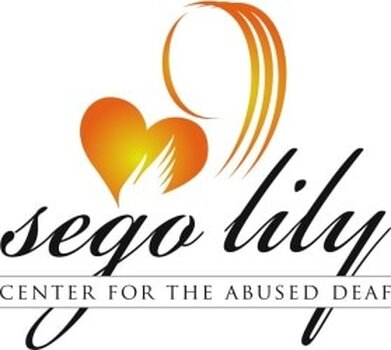
- The Equal Rights Amendment (ERA), which aims to guarantee equal rights for all people regardless of gender, was proposed in the United States. Although it was passed by the United States Congress in 1972, it fell short of the 38 states required for ratification by the June 30, 1982 deadline. Utah was one of the vocal opponents of the Equal Rights Amendment in the 1970s and still remains so to this day.
- Wage disparities between men and women. Hiring, firing, advancement, pay equality, medical accommodations, and other employment situations in federal, state, and local government.
- Physical safety (preventing domestic violence, sexual assault, and sexual harassment). Discrimination is inherent in large backlogs of untested rape kits and uninvestigated rapes. Law enforcement is inadequately trained to deal with gender violence and to minimize/ignore gender-based crimes. Women are imprisoned at significantly higher rates for self-defense. Child custody is often at stake in high-conflict divorce cases involving domestic violence. Our Sego Lily Center for the Abused Deaf is located in Salt Lake City, Utah, and can be reached at slcad.org
- Women are more likely than men to be impoverished. Therefore, the need for safe and affordable housing is critical, as is the discriminatory enforcement of nuisance laws and evictions.
- Quality healthcare, including reproductive services, is available. However, in hospitals, there is a lack of kits, training, and forensic nurses for sexual assault intake.
- Access to safe and legal abortion is necessary after Roe vs. Wade's overthrow in 2022.
- Comprehensive sex education.
- Women in the military. The shortcomings of our military in dealing with sexual harassment and assault reports.
- Human trafficking is a crime. However, laws on sex trafficking are being implemented in a discriminatory manner.
- Racial Injustice. The impact of gender and racial inequality on women in the labor force, including gender and racial wage disparities.
- Paid maternity leave (The United States is the only developed country where employers are not required to cover parental leave). Paternity leave is longer and more readily available than maternity leave.
- Women still struggle to break through the glass ceiling in leadership positions. As an example, consider Hillary Clinton.
Let's Challenge the
Status Quo Successfully!
Status Quo Successfully!
Women's rights have been disregarded for a long time, and unfortunately, they are still prevalent today. Sharon Weeks, the author of "It Seems to Me: What Young Women May Not Know," observed that many young women are unaware of the history of women's rights and are comfortable with their current status. She emphasized the importance of learning about women's rights and challenging the current status quo. Young women's lack of interest could harm future generations, including daughters and granddaughters (Weeks, Leader-Telegram, February 19, 2017).
As someone who values self-reliance, education, and career, I believe that Utah lacks women's empowerment due to the state's religious culture that prioritizes marriage and family. Women are more than just homemakers, mothers, and housewives. They can pursue education and a career to achieve their aspirations or goals. However, the United States needs to do much more to improve women's access to education, healthcare, and technology. Women's rights are basic human rights that everyone should support, so let's collaborate to make them a reality!
As someone who values self-reliance, education, and career, I believe that Utah lacks women's empowerment due to the state's religious culture that prioritizes marriage and family. Women are more than just homemakers, mothers, and housewives. They can pursue education and a career to achieve their aspirations or goals. However, the United States needs to do much more to improve women's access to education, healthcare, and technology. Women's rights are basic human rights that everyone should support, so let's collaborate to make them a reality!
A Slideshow of the
Utah Women's March in
Salt Lake City, Utah
January 23, 2017
Rally in Utah State Capitol Puts Focus on Equal Rights Amendment
December 3, 2019
December 3, 2019
On December 3, 2019, State Representative Karen Kwan, D-Taylorsville, introduced legislation for Utah to ratify the Equal Rights Amendment (ERA) to the Constitution of the United States in 2020. Around 200 supporters, including Deaf advocates, UAD President, Kim Lucas, SLCAD President Robert Belshe, UAD board member, Brooke Budzinski Groosinger, Honor Belshe (Robert’s 15-year-old daughter), and I joined the rally at the Utah State Capitol in support of this historic moment. It was a memorable day for all of us, and being part of history was an honor.
The History of Equal Rights
Amendment in Video, 2020
A Slideshow of
Representative Karen Kwan
introducing a resolution for Utah to ratify the Equal Rights Amendment to the Constitution of the United States in 2020 at the Utah State Capitol
December 3, 2019
Representative Karen Kwan
introducing a resolution for Utah to ratify the Equal Rights Amendment to the Constitution of the United States in 2020 at the Utah State Capitol
December 3, 2019
Utah Women's Equality Day
August 26, 2021
Read the attached articles to gain a deeper understanding of women's equality issues
Consider signing up for the following
newsletters and petitions to learn about and safeguard your rights:
newsletters and petitions to learn about and safeguard your rights:
- Utah ERA Coalition - https://utaheracoalition.org
- Utah Women and Leadership Project - https://www.usu.edu/uwlp/
- Ms. Magazine - http://msmagazine.com
- National Women Law Center - http://www.nwlc.org
- Equality Now - www.equalitynow.org
- National Organization for Women - https://now.org
- League of Women Voters - https://www.lwv.org
- Equal Rights Amendment - www.equalrightsamendment.org
- Equal Means Equal - http://equalmeansequal.org
- ERA Coalition - http://www.eracoalition.org
- Generation Ratify - https://www.generationratify.org/
- Alice Paul Institute - https://www.alicepaul.org
- A Mighty Girls - https://www.amightygirl.com
References
"Abigail Adams urges husband to “remember the ladies." History.com. https://www.history.com/this-day-in-history/abigail-adams-urges-husband-to-remember-the-ladies
Brooks, Joanna, Steenblik Rachel Hunt and Wheelwright, Hannah. "Mormon Feminism Essential Writing." Oxford University Press, 2016.
Brady, Ellen. "Guest opinion: Validate the ratification of the ERA." Standard-Examiner, June 21, 2023. https://www.standard.net/opinion/guest-commentary/2023/jun/21/guest-opinion-validate-the-ratification-of-the-era/?mibextid=Zxz2cZ&fbclid=IwAR0pLMFPN6MrGD05Epp_Wge3o9_T-7jFOSy-O-esov
Collett Katelyn. "Former Utah Supreme Court Justice Speaks on Equality at the U." The Daily Utah Chronicle, March 12, 2019. https://dailyutahchronicle.com/2019/03/12/former-utah-supreme-court-justice-speaks-on-equality-at-the-u/#:~:text=She%20told%20the%20Chronicle%2C%20%E2%80%9CI,systems%20that%20are%20meant%20to
Clark, Rebekah. First Woman to Vote in Utah and the Modern Nation. Better Days 2020. https://www.utahwomenshistory.org/bios/seraph-young/
Gallaudet University Library Deaf Collections and Archives, "Records of National Fraternal Society of the Deaf, 1900-2006."
Francis, Roberta. "The Equal Rights Amendment: Frequently Asked Questions." The Equal Rights Amendment. www.equalrightsamendment.org
Gehrke, Robert. “Gehrke: Utah lawmakers should heed remarkable women’s march as call to action.” The Salt Lake Tribune, January 23, 2017.
Havens, Emily. "Mormon and feminists: Not an oxymoron - a rich history." The Spectrum, February 24, 2018. https://www.thespectrum.com/story/news/2018/02/24/mormon-and-feminist-not-oxymoron-rich-history-lds-church/345375002/
Jan. "The Suffrage Movement," February 23, 2009. https://www.ldswomenofgod.com/2009/02/23/the-suffrage-movement/
Jones, Kelly Whited. "Kelly Whited Jones: 100 years later, women are still fighting for equality and the ERA." The Salt Lake Tribute, July 23, 2023.
“Locals.” The Buff and Blue, vol. 10, no. 1 (October 1901), p. 29.
"Martha Hughes Cannon," Wikipedia, January 22, 2019. https://en.wikipedia.org/wiki/Martha_Hughes_Cannon
Mary Woolslayer Photograph Collection. (1890). J. Willard Marriot Library, University of Utah. Collection Number UU_P0669.
"Maud Babcock," Wikipedia, December 28, 2018. https://en.wikipedia.org/wiki/Maud_Babcock
Pemberton, Jennifer. "When the Equal Rights Amendment Came to Utah." Utah Public Radio, August 25, 2016. https://www.upr.org/news/2016-08-25/when-the-equal-rights-amendment-came-to-utah
Rich, Amy, (2020). The ERA Deadline Removal Reasons.
Stack, Peggy Fletcher. “New book explores an early Mormon dichotomy: Women defending polygamy while pushing a feminist agenda.” The Salt Lake Tribune, January 9, 2017.
Toone, Trent. "10 remarkable women in LDS Church history." Deseret News, May 7, 2014.
Quist, Michelle. "Michelle Quist: For the Conservation Case for the Equal Rights Amendement." The Salt Lake Tribune, October 3, 2019. https://www.sltrib.com/opinion/commentary/2019/10/03/michelle-quist/
“US History Encyclopedia: Gallaudet University.” http://www.answers.com/topic/gallaudet-university
Vaglanos, Alanna. “Thousands Marched On Utah State Capitol Calling For Women’s Equality.” The Huffington Post, January 25, 2017.
Weeks, Sharon. "It seems to me: What young women may not know." Leader-Telegram, February 19, 2017. http://www.leadertelegram.com/Opinion/Commentary/2017/02/05/lt-div-class-libPageBodyLinebreak-gt-What-young-women-may-not-know-lt-div-gt.html
"Wyoming Grants Women The Vote." History.com, 2009.https://www.history.com/this-day-in-history/wyoming-grants-women-the-vote
Brooks, Joanna, Steenblik Rachel Hunt and Wheelwright, Hannah. "Mormon Feminism Essential Writing." Oxford University Press, 2016.
Brady, Ellen. "Guest opinion: Validate the ratification of the ERA." Standard-Examiner, June 21, 2023. https://www.standard.net/opinion/guest-commentary/2023/jun/21/guest-opinion-validate-the-ratification-of-the-era/?mibextid=Zxz2cZ&fbclid=IwAR0pLMFPN6MrGD05Epp_Wge3o9_T-7jFOSy-O-esov
Collett Katelyn. "Former Utah Supreme Court Justice Speaks on Equality at the U." The Daily Utah Chronicle, March 12, 2019. https://dailyutahchronicle.com/2019/03/12/former-utah-supreme-court-justice-speaks-on-equality-at-the-u/#:~:text=She%20told%20the%20Chronicle%2C%20%E2%80%9CI,systems%20that%20are%20meant%20to
Clark, Rebekah. First Woman to Vote in Utah and the Modern Nation. Better Days 2020. https://www.utahwomenshistory.org/bios/seraph-young/
Gallaudet University Library Deaf Collections and Archives, "Records of National Fraternal Society of the Deaf, 1900-2006."
Francis, Roberta. "The Equal Rights Amendment: Frequently Asked Questions." The Equal Rights Amendment. www.equalrightsamendment.org
Gehrke, Robert. “Gehrke: Utah lawmakers should heed remarkable women’s march as call to action.” The Salt Lake Tribune, January 23, 2017.
Havens, Emily. "Mormon and feminists: Not an oxymoron - a rich history." The Spectrum, February 24, 2018. https://www.thespectrum.com/story/news/2018/02/24/mormon-and-feminist-not-oxymoron-rich-history-lds-church/345375002/
Jan. "The Suffrage Movement," February 23, 2009. https://www.ldswomenofgod.com/2009/02/23/the-suffrage-movement/
Jones, Kelly Whited. "Kelly Whited Jones: 100 years later, women are still fighting for equality and the ERA." The Salt Lake Tribute, July 23, 2023.
“Locals.” The Buff and Blue, vol. 10, no. 1 (October 1901), p. 29.
"Martha Hughes Cannon," Wikipedia, January 22, 2019. https://en.wikipedia.org/wiki/Martha_Hughes_Cannon
Mary Woolslayer Photograph Collection. (1890). J. Willard Marriot Library, University of Utah. Collection Number UU_P0669.
"Maud Babcock," Wikipedia, December 28, 2018. https://en.wikipedia.org/wiki/Maud_Babcock
Pemberton, Jennifer. "When the Equal Rights Amendment Came to Utah." Utah Public Radio, August 25, 2016. https://www.upr.org/news/2016-08-25/when-the-equal-rights-amendment-came-to-utah
Rich, Amy, (2020). The ERA Deadline Removal Reasons.
Stack, Peggy Fletcher. “New book explores an early Mormon dichotomy: Women defending polygamy while pushing a feminist agenda.” The Salt Lake Tribune, January 9, 2017.
Toone, Trent. "10 remarkable women in LDS Church history." Deseret News, May 7, 2014.
Quist, Michelle. "Michelle Quist: For the Conservation Case for the Equal Rights Amendement." The Salt Lake Tribune, October 3, 2019. https://www.sltrib.com/opinion/commentary/2019/10/03/michelle-quist/
“US History Encyclopedia: Gallaudet University.” http://www.answers.com/topic/gallaudet-university
Vaglanos, Alanna. “Thousands Marched On Utah State Capitol Calling For Women’s Equality.” The Huffington Post, January 25, 2017.
Weeks, Sharon. "It seems to me: What young women may not know." Leader-Telegram, February 19, 2017. http://www.leadertelegram.com/Opinion/Commentary/2017/02/05/lt-div-class-libPageBodyLinebreak-gt-What-young-women-may-not-know-lt-div-gt.html
"Wyoming Grants Women The Vote." History.com, 2009.https://www.history.com/this-day-in-history/wyoming-grants-women-the-vote


